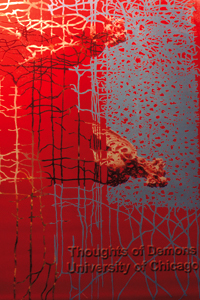Alumnus transforms neurological activity of memories into colorful art exhibition — ‘Neurotheology’
By Lien PayneNews Office
 Audrius Plioplys  In his artwork, Audrius Plioplys has hidden photographic images under layers of color, with the exception of one piece where the photo of one of the University’s gargoyles is visible. | |
When alumnus Audrius Plioplys (M.D.,’75) merged his two greatest interests, neurology and art, he developed a visual metaphor for the functions of the human brain.
Plioplys’ current works, group-titled “Neurotheology,” are on display in Rockefeller Memorial Chapel until Sunday, Oct. 29.
In the same way thoughts and ideas are transformed within the brain, Plioplys’ pieces are photographs and drawings that have been transformed to create images of neurological activity. The result is a colorful series of works that visually explore basic neurological function.
To create each piece, Plioplys used his own photographic works from previous exhibitions as underlying images. He transformed these images in a manner similar to the way the central nervous system transforms memory. The photographs, which he rendered into new images before hiding them beneath layers of color, represent memories that are stored through the neuronal network.
“Your own past experiences are locked in these neurons,” explained Plioplys. “I wanted to increase the level of philosophic complexity by going back into my own distant artistic memories—my installation pieces. If you subtract the color, the photographs are still underneath.”
Plioplys then used the drawings of 1906 Nobel Prize-winning scientist Santiago Ramon y Cajal, adding another layer of complexity to the works. Cajal’s neuroanatomy drawings were the first drawings to provide insight into the central nervous system.
While Plioplys’ works are symbolic, he admits that he made his creative decisions with aesthetics in mind. To represent “emergent properties” of human thought, he included the titles in the first half of his pieces. “I put the title of the piece in the work itself because our minds and brains are not only visual repositories; they also retain words,” said Plioplys. “But some people didn’t like the words in the pieces,” he said, and he decided to exclude them from the remaining pieces.
A neurologist, Plioplys’ love of art began more than 30 years ago when he visited a friend who was taking an oil painting class. After graduating from the University’s Pritzker School of Medicine, he faced a career choice between medicine or art. He chose neurology but never stopped making art, and the two eventually blended together as Plioplys began to explore his neurobiological research through his artwork.
Because his works represent the human brain’s ability to think philosophically, he sees them as spiritual. “It’s from these neurological networks that the human spirit comes from,” said Plioplys.
“It’s an honor for me to have my works displayed in this chapel,” said Plioplys, whose exhibition “Neurotheology” is on display in Rockefeller Memorial Chapel until Sunday, Oct. 29.
His artwork also is being exhibited at the Balzekas Museum, 6500 S. Pulaski Road, until January 2007, and at the Flafile Galleries, 217 N. Carpent, in Chicago. More information about Plioplys and his artwork is available on his Web site at http://www.Plioplys.com.
![[Chronicle]](/images/sidebar_header_oct06.gif)